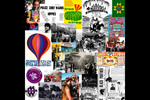|



| |
Deciphering 1% Free
Contents
|
Note: click the thumbnail images to view a large resolution version. Then
click again to return to this page.
|
The Poster
In the first weeks of 1968, a mysterious
six-foot tall poster airbrushed in jade blue on brown butcher paper
appeared overnight pasted to abandoned fences, bank walls, and public spaces
all around San Francisco. The image showed two stylized Tong warriors standing against a street corner with a Chinese
logogram in the upper corner and the words "1% Free" in bold lettering at
the bottom. This became a trademark image of the Diggers in their Free City
phase, and it was reprinted in numerous versions and editions over
subsequent years. This page will help decipher some of the details of this
iconic image and the speculation that has swirled around its meaning ever
since its first appearance.
At the time, as with all Digger activities, the poster was produced and
distributed anonymously. It was instantly seen as a provocative statement
with enigmatic meaning — something the Oracle at Delphi might have answered
to fateful questions posed by tremulous seekers. There have been many interpretations over time. Peter
Berg and Don Cochran designed the elements of the poster,
including choosing the image and the phrase "1% free" and a group
of Diggers participated in the artistic production and subsequent posting.
Peter Berg talked about the poster in an
interview
under the oral history section on this site:
Peter Berg: Somebody had a great idea — let’s make something and put it
on the walls and it will be like our “Digger ad.” The Diggers should have an
ad, right? Let’s just make an ad that is absolutely cryptic. It was bigger
than anything else. It doesn’t look like anything else. And let’s put it on
freeway stanchions, and, you know we put some on men’s room doors in the
park, just weird, Bank of America right over their plate glass windows. Just
went out one morning, just the way we made the posters, we distributed them.
We gave one to all the storekeepers on Haight Street. They all thought it
was a threat. [Laughing] They thought 1% Free meant we were the mafia. We'd
beat them up if they didn't give it to us. [Laughter.] And being around
Billy Fritsch would give you that impression. One hundred and seventy of
those put on walls all over the city one day. It was a great idea, right?
People would say, “What does 1% Free mean?” And I’d always say, “I’m glad
you asked that. It was supposed to make you ask me what it meant.” “Well,
that’s being deliberately confusing.” “No, it’s not. It’s being inspiring.”
Emmett Grogan also recounted the making of the poster in Ringolevio. Here
is what he had to say:
Emmett Grogan: The cover of the document was titled "The Digger Papers,"
and ... on the outside back cover was what many
people who knew him thought was the Hun's most brilliant and poignant
statement in art. It was a black-and-white reproduction of a
six-by-three-foot, blue-and-white poster of two Tong assassins, calmly
biding their time, leaning against the corner of a brick building. Above
them hung a sign with the Chinese character from the I Ching that spelled
revolution, and written below their feet in black letters was the slogan I%
FREE. The Hun designed the original poster with a friend called Red-Cock Don
and with several others posted them on walls throughout Chinatown and all
over the city, to the consternation of the Chinese and the wonderment of
everyone.
Interview of Peter Berg
here.
Emmett Grogan's Ringolevio
here. [Note: "Hun" and "Red-Cock Don" were Emmett Grogan's pseudonyms for Berg and
Cochran in Ringolevio.]
|
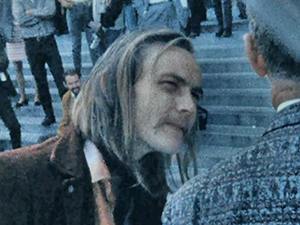
Peter Berg in
Nowsreal (1968)
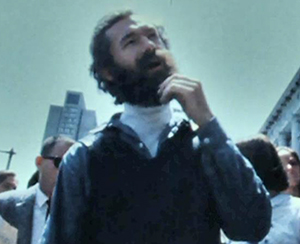
Don Cochran in Nowsreal
(1968)

Original poster pasted on storefront wall.
|
The Inspiration
|
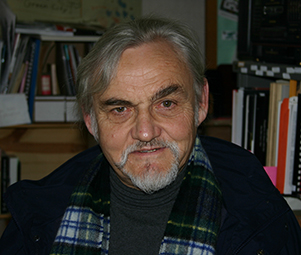
Peter Berg talks about the elements of the "1% Free" poster in this interview
from 2009 by Shaping San Francisco.
Photo by eric, 2004.
|
The Photo
In Peter's interview, he ascribes the inspiration for the
air-brushed image of the two Tong warriors to a photograph
by Arnold Genthe. Genthe was a turn-of-the-century
photographer whose vast collection of Chinatown images are a
treasure from a long-lost period in pre-1906 earthquake San
Francisco. His photographs have been reprinted in numerous
editions, and his memoir is another jewel for anyone
interested in the life of this peripatetic artist.
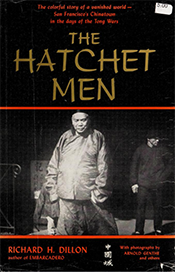 However,
Berg's memory of Genthe as the photographer of the Tong
warriors is not correct. The image (seen to the right) was
published in The Hatchet Men by Richard
Dillon. Note the authorship states, "With photographs
by Arnold Genthe and others." If you look closely at the
caption of the "two highlanders" it was
taken by Louis J. Stellman, and he signed the original
photo. Nevertheless, it was an easy mistake. [Interestingly,
various editions of Dillon's book do not include the same
set of images. The Stellman photo of the Tong warriors is one that is variously
missing.]
However,
Berg's memory of Genthe as the photographer of the Tong
warriors is not correct. The image (seen to the right) was
published in The Hatchet Men by Richard
Dillon. Note the authorship states, "With photographs
by Arnold Genthe and others." If you look closely at the
caption of the "two highlanders" it was
taken by Louis J. Stellman, and he signed the original
photo. Nevertheless, it was an easy mistake. [Interestingly,
various editions of Dillon's book do not include the same
set of images. The Stellman photo of the Tong warriors is one that is variously
missing.] |

"Two Highlanders" photo used by Berg as the model for the poster. (Photo by
Louis J. Stellman) |
The Slogan
Peter also mentions in the Shaping SF interview that the
idea for the "1%" part of the slogan came from a patch the
Hells Angels had devised. The history of the involvement of
the Diggers and the Hells Angels is a whole other topic for
discussion. But, for the purposes of this treatment, it is
enough to note that this collaboration (perhaps more at
arm's length than not) led to the marriage of FREE with the
image of an Angels "1%er" patch. In other places, Berg
talked about the power of combining FREE with everyday
words. "Free Food, Free Bank, Free Store" etc.
There have been innumerable interpretations over the
years of "1% Free" and one of my favorites is in a long-lost
interview of Arthur Lisch who had this to say:
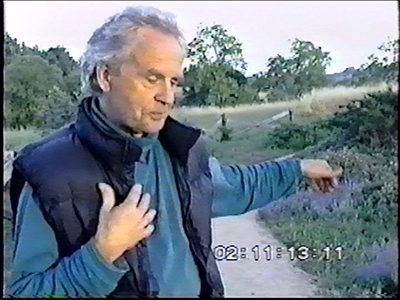
Arthur Lisch: The initial beginning [of the Earth Circle
he was creating in a public commons] goes back to that
poster that was made that said ‘1% Free’ … The idea of being
“1% free” means that, to me, we can take that initiative, we
can take that step, and then things will fall into place
around it. This was initially 1% free. It’s not 100% free
now, but so many people have come here, worked here, care
for the place, they’ve claimed this circle of land in the
name of community and the name of the sacred in life, in the
name of a higher way of being. … In other words, to see the
higher in each other, for each of us to see what is better,
what is hopeful, what is possible in each other. And this
small circle is dedicated to that.
See the full Arthur Lisch interview
here. |
 |
The Production
The making of the poster was a collaborative event that
involved not only Peter Berg and Don Cochran as the the designers but also Freeman House and David Simpson who were
publishing the Free City News sheets. Their contribution was
the printing of the heads and hands that were cut out and
pasted onto the airbrushed sheets of butcher paper. Here is
Freeman's description of the event:
Freeman House: Right as we were moving into the house,
David and I were starting Free News, which we operated for
the first few weeks out of an office above the Straight
Theater. And it was just at the time that we moved into this
house that things really began to pop in terms of moving
together and doing things together and moving out into the
city as it grew. It was about that time that Peter Berg
first made the big 1% Free poster which was a beautiful
piece of work, it really was. He took a photograph of those
two Tong warriors lounging on a street corner, enforcers,
blew them up, cut out the outlines, and spray painted the
bodies with a ... you know, the compressor? Spray gun?
Xeroxed these faces and hands and they were pasted on there. |
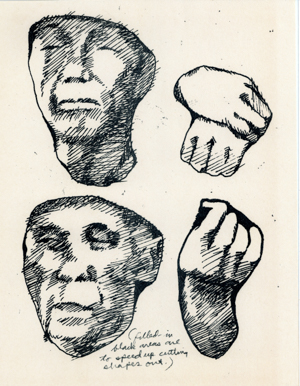
The faces and hands for the 1% Free poster were printed on the Gestetner
mimeograph that was used for Free City News.
|
The Ideogram
Emmett Grogan described the Chinese ideogram in the upper
right-hand corner of the poster as the "Chinese character from
the I Ching that spelled revolution." In the reproduction of
the poster (for example, in the Digger Papers), the ideogram
is highly stylized. But on the original butcher paper (as
seen here) the brushstrokes are much clearer. And, compared
to the character for Hexagram 49 of the I Ching
("Revolution") in the Wilhelm edition (see below) Grogan got
it right.
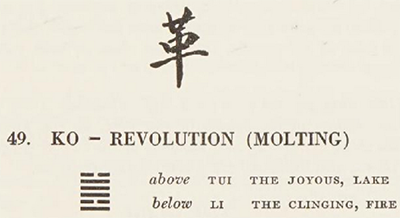
|
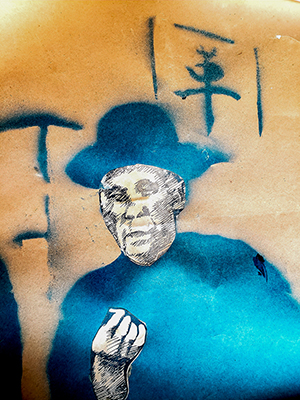
Photo of the upper right corner of an original 1% Free poster. Note the detail
of the Chinese ideogram.
|
The Reverberations
Freeman House: And then one night, I think there were something
like a hundred of those done, one night we got them all on
walls all over the city. And I was very excited. Peter has a
talent for doing things that seem at the moment theatrical
but somehow turn out to be just the right key at the right
moment, you know, and that was one of them. All of us were
trying to figure out what that poster meant, you know. I was
in on the spray painting and I didn’t know what it meant.
And it was only a few weeks later that we came up with that
page that appeared in the Express Times which said what it
meant. It was like a financing idea. The financing idea
never worked at all. Occasionally you’d get some money out
of those merchants and record makers and bands and dope
dealers but not very often. But that image, somehow, just
everybody knew, somehow, in an inarticulate way, what it
was. You’d relate to people through that image. It was very
strange. Very magical, very magical. You can still, somebody
blew them down and put them on little cards. You could go
almost anywhere with those cards and people would pick up on
them, even Washington. You could put them in the window of
your car, you know, and people would come up to you and say,
“Wow, you’re one of these people.” Read the full Freeman
House interview
here. As Freeman mentioned, immediately after the original six-foot-tall 1% Free
poster appeared, it was copied and printed in numerous
formats. Emmett Grogan (it was told me) was responsible for
the 17" x 22" version which is occasionally (though rarely)
seen on the rare ephemera market. Likewise, different sized
versions were printed in card format. I've even seen cloth
patches. The San Francisco Express Times printed the full
page Free City Bank ad (seen to the upper right) on February 29, 1968. And then here
is most interesting article written by Marjorie Heins who
seems to have missed the whole Digger/Free City phenomenon,
not arriving in San Francisco until the end of 1968.
Nevertheless she has an analysis of the Diggers (mainly from
reading the Digger Papers) that juxtaposes Free with Black
Power and with anthropological theory. Notice that the "1%
Free" label of the poster has gone missing from this
reproduction, one year after its first appearance. [Added
2024-02-22] Right (upper image): Full page notice for the
Free City Bank that appeared in the San Francisco Express
Times, February 29, 1968.
Right (lower image):
"Who's Going to Collect the Garbage?" by Marjorie Heins, SF Express Times,
January 7, 1969. |
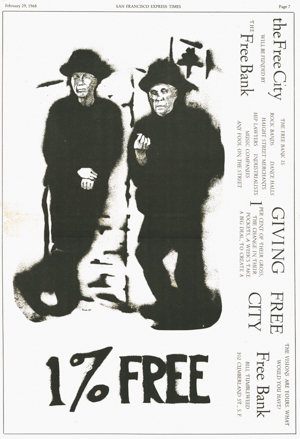
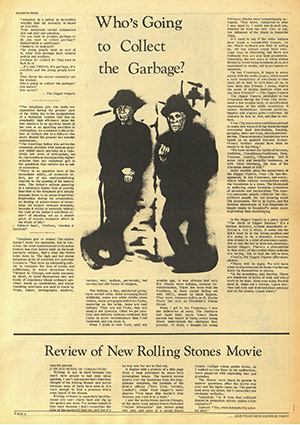
|
The Connection
After I posted the first iteration of this page, Billy
Murcott wrote and said that, for him, the image on the 1%
Free poster was emblematic of Gregory Corso's poem "Standing
on a street corner waiting for no one is power." Yes! Of
course. Let me emend this page to amplify Billy's reminder.
In going through the vast collection of Digger street
sheets that Freeman House donated to the archive after his
apartment fire, I found a sheet that had been overlooked
until then. Titled "term paper" it laid out one of the
fundamental inspirations for the Diggers. Here is an excerpt
from this amazing document:
term paper: the relationship between poetry and
revolution has lost its ambiguity — Gregory Corso's poem
POWER was the sole reason behind concept of the Diggers:
autonomy. ... power is standing on a streetcorner
waiting for no one
That last sentence was one the Diggers used in various
contexts. And they quoted it from Corso's poem. The only
problem was I couldn't find the poem. Corso wrote a play,
"Standing on the Street Corner" but where was the poem that
quoted the line? Finally, in putting together a presentation
on the life and times of Irving Rosenthal, I found it. In
1958, Irving was a graduate student at the University of
Chicago and editor of the nationally recognized literary
magazine, the Chicago Review. Irving had overturned the
traditional focus on academic poetry and had included the
San Francisco Beats along with the first publication of
Burroughs' Naked Lunch. In response, the university
administration banned the next issue of
the Review. Irving resigned as
editor, fled to New York City, and, under Allen Ginsberg's
sponsorship, published the first issue of Big Table with the
manuscripts he took with him. One of those was a collection
of three poems by Corso, including POWER. Here is the
pertinent stanza from this long poem:
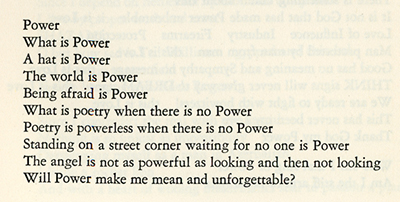
Excerpt from Corso's poem POWER that appeared in Big Table 1
with the line that the Diggers would adopt as a model of
autonomy: "Standing on a street corner waiting for no one is
Power"
|
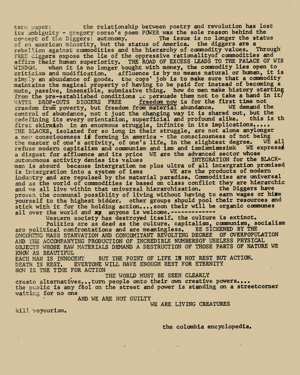
"term paper" — a text that holds the key to understanding early Digger Papers.
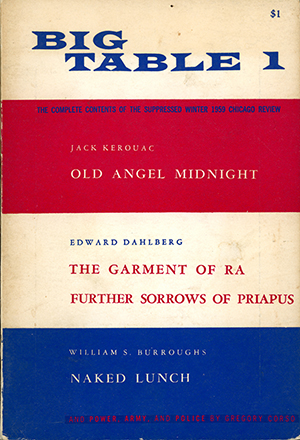
Cover of Big Table 1, containing the material that Irving Rosenthal had
solicited for the Winter 1958 issue of Chicago Review before it was banned by
the U of Chicago admin.
Click here
for a PDF of Corso's poems in Big Table 1 (16mb).
|
[Top]
|
